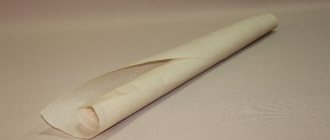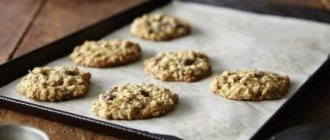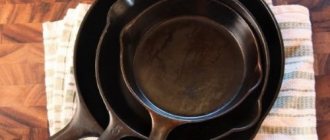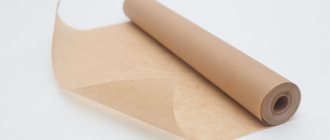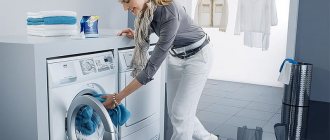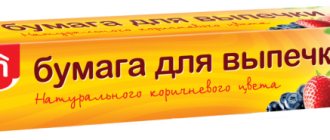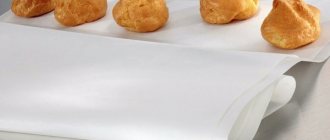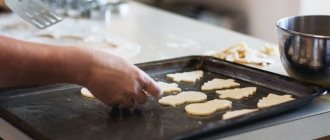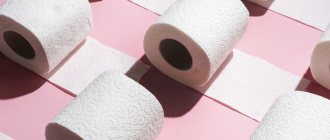Parchment paper is thick paper with a smooth surface, specially designed for use during baking, as well as for packaging products.
Its advantages include:
- high moisture and grease resistance;
- withstands temperatures of 230° C for a long time.
Using parchment paper during baking prevents the dough from sticking to the bottom and walls of the baking sheet, and also makes it possible to roll out extremely thin layers of shortbread and puff pastry, placing them between two parchment sheets and transferring them directly to the baking sheet. How you can replace parchment paper when baking will be suggested by the advice of experienced chefs.
How to replace parchment paper when baking?
The purpose of baking paper is to prevent the product from sticking to the baking sheet and prevent it from burning. It also protects against burning if the filling (juice) leaks. Based on this, you can find a replacement for baking paper from what you have on hand.
How to replace parchment paper when baking:
- Drawing tracing paper coated on both sides with vegetable oil;
- Regular office paper (clean), also oiled;
- Food-grade parchment (thick paper that supermarket baking bags are made from).
If you don’t have any of the above at home, you need to generously grease a baking sheet with oil or cooking oil and sprinkle with semolina or breadcrumbs. This will help prevent burning, and the baked goods will be easy to remove from the pan.
A special silicone mat will serve as an excellent replacement for baking paper. It is convenient to roll out and shape dough, as well as bake. It does not melt at high temperatures and does not react with foods, so it is completely safe. In addition, such a mat lasts a very long time, so you don’t have to constantly remember whether you still have baking paper or have already run out. There are convenient silicone molds for baking bread, muffins and pies.
Baking bag and flour packaging
Baking paper can be replaced with a regular baking bag. The bags have high resistance to hot temperatures. It is better to use packages as a last resort, when there are no other means at hand. The product will prevent baked goods from burning - this is its only benefit.
Have you noticed what the flour packaging is made of? Its properties are very similar to parchment. Often this is ordinary baking paper. Pour the flour into a separate container, lightly oil the packaging and start baking. Place the dough on the inside of the package to prevent the paint from imprinting on your pies.
Is it possible to replace baking paper with foil?
If you have food foil at home for baking, it can also be used instead of paper, but with some nuances:
- If you bake dough products, the foil should be greased with oil. There is no need for baking vegetables, fish, or meat;
- To prevent the dough from sticking to the foil, place it with the matte side on a baking sheet and the shiny side on top.
You also need to remember that the matte side can oxidize due to contact with the product and change its taste.
Foil can not only be placed as a sheet on a baking sheet, like paper. You can make any arbitrary shape from it, for example for a pie. The sides will prevent leaked juice from getting onto the baking sheet and burning. To create the molds, you need to take two or even three layers of foil, then it will fold easily and will not tear. To prevent the top of the pie from becoming too hard, you can cover it with a sheet of foil and remove the sheet about 10 minutes before it’s ready to allow the top to brown slightly.
Knowing what you can replace baking paper with, you won’t find yourself in a hopeless situation if it suddenly runs out, and baking will always be successful.
When baking something on a baking sheet in the oven, housewives usually use special baking paper. But what if it ends at the most inopportune moment? How to replace baking paper?
Tracing paper
Baked goods will not burn on tracing paper. It is used in the sewing industry to make patterns for clothes. It is similar to parchment both in appearance and in its properties. Before use, make sure the material is clean.
The difference is that the tracing paper was not pre-greased. You need to do this yourself, by analogy with writing paper. You can replace baking paper with tracing paper if the dough does not need much time to bake. Tracing paper does not have the same durability as its culinary competitor.
This is interesting: How to care for your fingernails
How to replace parchment paper when baking?
The purpose of baking paper is to prevent the product from sticking to the baking sheet and prevent it from burning. It also protects against burning if the filling (juice) leaks. Based on this, you can find a replacement for baking paper from what you have on hand.
How to replace parchment paper when baking:
- Drawing tracing paper coated on both sides with vegetable oil;
- Regular office paper (clean), also oiled;
- Food-grade parchment (thick paper that supermarket baking bags are made from).
If you don’t have any of the above at home, you need to generously grease a baking sheet with oil or cooking oil and sprinkle with semolina or breadcrumbs. This will help prevent burning, and the baked goods will be easy to remove from the pan.
People's Councils
The baked goods will not burn and will not stick to the bottom and walls of the pan:
- If you grease it with butter and sprinkle it with a thin layer of flour, semolina, breadcrumbs or bread crumbs.
- If you line the bottom of the baking sheet with a baking sleeve.
- If you put fax paper on the bottom of the form.
- If you use the most ordinary A4 writing paper as a substrate, soaked in margarine, vegetable or butter, lard. For this purpose, clean notebook sheets or clean printing paper are also used.
- If you line the bottom of the baking sheet with paper butter wrappers (not foil).
- If you cover the bottom of the baking sheet with a cut flour bag (usually a flour bag is made of light brown parchment paper).
- You can do without parchment paper if you use a greased Teflon-coated pan for baking.
Is it possible to replace baking paper with foil?
If you have food foil at home for baking, it can also be used instead of paper, but with some nuances:
- If you bake dough products, the foil should be greased with oil. There is no need for baking vegetables, fish, or meat;
- To prevent the dough from sticking to the foil, place it with the matte side on a baking sheet and the shiny side on top.
You also need to remember that the matte side can oxidize due to contact with the product and change its taste.
Foil can not only be placed as a sheet on a baking sheet, like paper. You can make any arbitrary shape from it, for example for a pie. The sides will prevent leaked juice from getting onto the baking sheet and burning. To create the molds, you need to take two or even three layers of foil, then it will fold easily and will not tear. To prevent the top of the pie from becoming too hard, you can cover it with a sheet of foil and remove the sheet about 10 minutes before it’s ready to allow the top to brown slightly.
Knowing what you can replace baking paper with, you won’t find yourself in a hopeless situation if it suddenly runs out, and baking will always be successful.
Who doesn't love to treat themselves to fresh baked goods for dinner? Light and airy meringue, soft puffs with raspberries, pies, sweet and salty - everything your heart desires. Every housewife has her own culinary secret. One uses parchment paper for baking and baking, the other uses oiled paper or foil. The taste of the prepared dishes depends on what you cover the baking sheet with. Of course, the most convenient way is parchment paper. But if you suddenly don’t have such paper at hand, you can find a replacement.
No additional funds
Cookies made from not too capricious dough can be placed directly on a baking sheet without the use of special tools. Just grease it with butter or margarine.
Advice! Do not use this technique for products such as meringues or macarons; without paper they will definitely burn. But the method is convenient and economical for baking pies, casseroles, and biscuits.
You can reduce the risk of the confectionery product burning if you have semolina on hand. Just sprinkle it on an oiled baking sheet. Instead of cereal, breadcrumbs are suitable. As a last resort, take wheat flour. If you have dry bread or large crackers, you can grind them using a blender. You can bake it in a non-stick frying pan. It does not require special coatings; just grease the bottom and sides with butter.
We recommend: 5 tricks for safe preservation: how not to scald your hands and drain the first boiling water from the jar
What is baking parchment?
Parchment paper, or its other name, baking paper, is a unique material that has a lot of advantages. It is not subject to combustion, does not get wet or crumble, is greaseproof and resistant to high temperatures, and also retains the shape of baked goods and its aroma, preventing the entry of foreign odors. The parchment is impregnated with a solution of treated sulfuric acid (during the manufacturing process, after applying the solution, the parchment is immediately washed), and it is absolutely harmless for preparing confectionery and any other products on it, it can be used repeatedly, maybe once, depending on the quality of the parchment sheets.
Baking parchment is used to prevent baked goods from burning.
How to use baking paper
Place this paper on a baking sheet and cover a baking and baking dish with it. It serves as a layer between a baking sheet, frying pan or a special form and the dish that is being prepared on them. This way the product will not burn, stick, or cause damage to the dishes, which is also a clear plus. It must be remembered that the parchment should not touch the walls or oven door, it should only come into contact with the baking sheet itself, the mold and the dish. Parchment paper can also be used in the preparation of cold-process confectionery products, such as cheesecakes, in which case its main function is to preserve the shape of the product.
I cover the bottom and sides of the pans and baking trays with baking parchment.
Paper baking dishes
Paper molds for muffins, Easter cakes and desserts are indispensable in the modern kitchen. These versatile cups come in a variety of sizes and colors. Their main advantages are environmental friendliness, low price and elegant appearance (baked goods can be served directly in them). The only drawback is one-time use.
Paper molds also differ in density: in tougher ones, the products are baked directly on the oven rack, and thin cups are placed on a baking sheet. They are first lubricated from the inside with oil with a special brush for convenience.
Note:
- cups for cupcakes or muffins are filled with dough to 2/3 of the volume;
- Easter cake molds are filled 1/3 with yeast dough.
After cooking, the products do not need to be removed from the paper form. It will serve as decoration and maintain the hygiene of the finished product.
Parchment and baking paper - is there a difference?
There is a difference, but it is quite insignificant. Parchment is denser and is well suited for baking butter-based products, while paper will become soggy due to the fat released.
Parchment is intended both for baking products and for storing them. Usually very fatty or very moist products are stored in it, such as butter, spread, margarine or curd products. Confectionery and bakery products are baked in parchment. If the parchment is additionally covered with a silicone film on top, its water- and grease-repellent properties increase, then it is used for baking butter products from liquid dough.
Replace with writing paper
You can replace parchment paper with regular paper. This method is suitable for baking sponge cakes. For such a delicate dessert as meringue, it is better to use thick paper. The main thing is that there are no images on it, as the ink will remain on the dough and spoil the taste.
Before placing the dough on the paper, you need to generously grease it. Butter or margarine works best. To speed up the process, the oil is first ground to a creamy state. It is not advisable to melt the butter: this will only cause the paper to fall apart.
Do they need to be lubricated with oil?
Parchment paper is not greased for baking high-fat products, but additional greasing will be required for cooking low-fat and low-fat products. Paper has less grease-repellent properties than parchment, and to avoid products sticking to it, it should be lubricated.
For baking low-fat products, grease parchment paper
What not to use, safety rules
It is unsafe to use the following raw materials for baked confectionery products:
- Newspapers. This is a very fragile type of paper, and also impregnated with ink. They will leave imprints on the baked goods and are unlikely to be beneficial to your body.
- Dry writing paper is not used. Be sure to grease the paper with oil before you put the dough on it and put it in the oven, otherwise you will end up not being able to separate the food from the paper.
- It is not advisable to use vegetable oil for lubrication. The product does not prevent products from burning, no matter how high quality it is. But the taste and aroma will definitely be spoiled.
- Polyethylene. Its composition differs from baking bags. At high temperatures the substance may melt. Not only will the dish be spoiled, but there is also a risk of damage to kitchen utensils and household appliances, as well as accidents.
Before cooking using improvised means, you need to test them. What if they fail the oven test? Simply place a piece of the item in a preheated oven and wait 15 minutes. If the item does not catch fire, curl up or smoke, then it is safe, and you can start creating culinary masterpieces. Before cooking, make sure your baking materials are intact and free of dirty stains and foreign odors.
The kitchen is a place for true creativity. If you show your imagination, you can easily create masterpieces using improvised means!
How can you replace parchment paper for baking?
There are situations when you really want to bake something, but you don’t have parchment paper at hand. Let's look at what can replace it in the table.
Table: pros and cons of various options for replacing parchment paper.
| Replacement options | pros | Minuses | Is lubrication required? | What can you bake? | What can't you bake? |
| Drawing (or sewing) tracing paper |
|
| Required | Suitable for baked goods with a high fat content (for example, shortbread or yeast dough) and for cold baked goods (cheesecakes). |
|
| Absorbent paper |
|
| Not required | Moisture-absorbing paper is suitable for baking products with medium fat content - cottage cheese products, bread, kefir baked goods. Even without lubricating such paper, they do not stick. | You cannot bake very fatty products on such paper, such as cookies with sour cream or shortbread, butter cakes. |
| Regular office paper impregnated with oil |
| Required | Oiled office paper is suitable for baking unpretentious and simple products, such as Easter cottage cheese or cookies. | Not suitable for baking French macarons and strudels. | |
| Silicone Baking Mat |
| Not required | A silicone mat is a universal device; you can bake whatever you want on it; its surface will not damage the shape of the products or affect their structure. | ||
| Silicone coated paper |
| Not required | Silicone-coated paper easily releases from finished baked goods, so it can be reused many times, and is suitable for any type of dough (for a fancy sponge cake, use it only once, otherwise it will start to stick). | ||
| Baking bag |
|
| Not required | You can bake shortbread cookies in a baking bag | You cannot bake juicy pies and pies. |
| Foil |
| Required | You can bake cookies on shiny foil, but there is a high risk that they will burn. | Foil as a material is more suitable for baking juicy things, not for baking. | |
| Silicone baking molds |
| Not required | Any type of dough can also be baked in silicone molds; it is important to remember that they are only filled one-third full, because the dough greatly increases in volume during baking. | ||
| Paper baking dishes |
| Not required | Paper molds are suitable for baking muffins, cupcakes, Easter cakes and cupcakes. | Not suitable for baking with batters such as eclairs and profiteroles |
What is its peculiarity
Parchment paper is specifically designed for baking. It does not allow grease and water to pass through and is highly durable. Food baked on parchment does not lose its taste and does not absorb foreign odors. Baked goods do not dry out or burn. For baking, only food parchment is used; it does not contain any impurities dangerous to humans.
Is it possible to replace such a useful household item? The answer is yes! Available means include:
- writing paper,
- tracing paper,
- silicone molds and mats,
- foil,
- baking bags,
- flour packaging.
When the replacement will be unequal
Despite the variety of “substitutes,” it is important to remember those things that absolutely cannot be used for baking. This is for example:
- Newspapers - firstly, there is a high risk of fire, and secondly, when heated, they release toxic, poisonous substances contained in printing ink, which can become a source of poisoning.
- Written notebook sheets - ink also contains substances that become hazardous to health when heated.
- Unoiled office paper can easily catch fire.
- Vegetable oil does not protect the product from burning, it smokes, and because of this it spoils the taste of the dish and gives it a not particularly appetizing smell.
- Plastic bags melt at high temperatures and release toxic substances.
Good housewives know many interesting secrets, many of which we have now shared with you. Have fun cooking and remember that the lack of baking paper is not a reason not to please yourself or your family!
Silicone molds and mats
Silicone molds are available for sale. Molds are made in different sizes and purposes: for cupcakes, for cookies. They even sell silicone mats for bulky confectionery products. The advantage of silicone is that it can be reused many times. The material is suitable for any type of baking.
Advice! To remove the cookies from the molds without damaging them, first let them cool slightly, then pry the edges with a spatula, turn them over and tap the bottom.
Silicone-coated paper is a new invention that has captured the hearts of housewives. It is available in sheets and rolls. Each sheet can be used up to 8 times. This material requires minimal maintenance, and they will serve you for a long time and reliably.
Sausages in dough and other simple recipes step by step
It is convenient to prepare simple and quick snacks in the air fryer.
Sausages in dough
The easiest way to make sausages in dough is to use a ready-made version of the dough. It does not matter whether it is puff paste or yeast. Ingredients
- 500 g puff pastry
- 5 sausages
Cooking steps
- Cut the dough into strips 2 cm wide. Twist the sausages into them.
- Bake at 205°C on medium speed for 15 minutes.
To achieve a golden brown crust, you can pre-brush the sausages with yolk or milk.
Hot sandwiches
This dish is perfect for breakfast and a quick snack. Ingredients
- 4 slices white bread
- 50 g herring oil
- 2 hard-boiled eggs
- 30 grams of cheese
- greenery
Cooking steps
- Grease the bread with butter, grate the cheese, cut the eggs in half.
- Place eggs on slices and sprinkle with cheese.
- Bake at 235°C for 5 minutes on high speed.
Before serving, sprinkle with chopped herbs.
Cheese puffs
Instead of cheese, you can use any filling in this type of baking: fried minced meat, cottage cheese with herbs, thick jam. Ingredients
- 500 g puff pastry dough
- 300 grams of suluguni cheese
Cooking steps
- Lightly roll out the dough and cut into squares.
- Place grated cheese inside each, seal the triangles and bake for 15 minutes at 180°C and medium fan speed.
You can make the filling more juicy by adding butter.
Tracing paper
One of the available materials that can replace parchment sheets is tracing paper. This is a thin transparent paper used for creating drawings and patterns. It can be purchased at office departments.
This paper is great for baking high-fat baked goods: yeast buns and pies, shortbread, cheesecakes and tiramisu. Tracing paper is used in a similar way to parchment paper. The difference is that before the baking process, the tracing paper must be well greased with butter or fat on both sides.
The disadvantage of this substitute is that it is less resistant to high temperatures, so when exposed to over +200 °C, the paper darkens and collapses. Sometimes the tracing paper sticks to the baked goods and is difficult to remove without touching the edges of the product.
Or maybe just grease the sheet?
When making casseroles, shortbread cookies, or apple pie, it is quite acceptable to simply grease a baking sheet or baking sheet with butter, sprinkle with flour, and shake off the excess. You can use crackers instead of flour. Teflon-coated pans greased with oil will also prevent baked goods from burning and sticking to the sides and bottom of the pan.
Advice! Do not use this method when baking meringues and macarons: they will stick to the baking sheet.
Types of paper
As a basis for baking, different types of materials are sold, differing in production technology, strength and non-stick properties:
- tracing paper;
- parchment;
- silicone coated parchment;
- silicone paper;
- muffin tins.
Tracing paper is white and thin to the point of transparency. It can be bought both in the form of cheap rolls and in the form of large format sheets. Tracing paper is only suitable for products made from yeast and shortbread dough and fairly dry cold confectionery products. It cannot be used for baking biscuit dough and baked goods containing little fat, as it will stick to them. In addition, it instantly becomes soggy, so you won’t be able to cook liquid-producing dishes with it. And if the tracing paper is heated for a long time, it will become brittle and break up into small pieces that will not be easy to separate from the baked goods.
By the way, be sure to try Yulia Vysotskaya’s plum pie - it’s something incredibly delicious!
Attention!
To prevent the baked goods from sticking, the tracing paper is coated with fat before placing the dough on it.
Parchment is denser than tracing paper and opaque. It is treated with a sulfuric acid solution for greater strength and grease resistance. There is no need to worry about the effects of sulfuric acid on products: during the production process, parchment undergoes washing and drying, which neutralizes the acid. Parchment can withstand heat and does not allow liquid or fat to pass through. Butter dough products are baked well on parchment, while retaining their shape perfectly. If you are preparing baked goods with a small amount of fat, then the sheet is coated with oil.
Silicone-coated parchment is suitable for preparing any product. It is grease and moisture resistant. Fish and meat are baked in it and reused for baking (although this does not apply to biscuit dough). A type of silicone-coated parchment used in commercial bakeries is rated for temperatures up to 300°C.
Delicious apricot pie
Delicious apricot pie lives up to its name. It is prepared from simple ingredients, with…
Silicone paper is coated with a thicker layer of silicone. It can be purchased in sheets and rolls. It is considered the most convenient. Paper muffin tins are made from paper-lined parchment. When baking, each cupcake is placed in its own separate mold, which is why they do not stick together.
